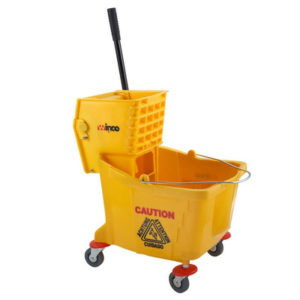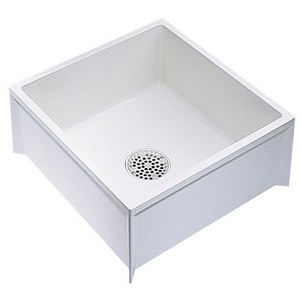So far in this blog series, The Power of Clean, we have talked about cookware in Part 1 and cleaning and sanitizing in Part 2. In Part 3, we will be discussing floor care. The floors in your establishment have the potential to be a hazard to your patrons and staff if not maintained on a daily basis. This is especially true for the back of the house where there are wet and greasy environments such as the dish area and the cook line. Also, without consistent deep cleaning between shifts, grease and soil can become compounded and pose an even greater health and safety hazard. In the front of the house, spills can happen without warning and pose a slip and fall hazard for your patrons. Should one of your patrons become injured due to a slip and fall, you may be held liable. Therefore, proper floor care is a critical task with great potential to make an impact in your establishment.
There are many different options available for flooring in foodservice establishments. One of the most commonly used types of materials for flooring, especially in the back of the house, is ceramic tile due to its durability and resistance to moisture. Therefore, for the purpose of our blog, we will be talking about ceramic tile. The same general cleaning principles still apply to other types of floor materials such as sealed concrete or vinyl tile, but you will still want to be sure to check the manufacturer’s specifications on the cleaning products you use. Having said that, your best options for cleaning your floor will be either a general, all-surface cleaner and warm water or floor cleaner specially formulated for your floor type. Commercial floor cleaners are available in several different formulas with different cleaning properties such as breaking down grease or oily residue. Again, be sure to check the manufacturer’s specifications to see if it is safe for your floor type. If you are using a degreaser, we recommend non-butyl degreaser. Butyl is a chemical compound that is destructive to petroleum and rubber-based plastics. A non-butyl degreaser will be safe for many different floor types and will help protect any such materials that come into contact with your floors such as your floor mats.
No matter which cleaning products you may be using for your floor care or otherwise, you will want to be sure to store them separately and away from food service and prep areas. Product containers should be clearly labeled and not reused for any other purpose. It is important to only use products approved for commercial foodservice. Furthermore, you are required by the Occupational Safety and Health Administration (OSHA) to have Material Safety Data Sheets (MSDS) on all chemical products in your establishment. MSDS contain information on safety precautions, potential hazards, first aid procedures, hazardous ingredients, and the manufacturer’s contact information. MSDS are right-to-know information and should be kept where all staff may easily access them. You can obtain MSDS from the manufacturer or your supplier. Here at Dine Company, we have MSDS for all chemical products we sell in our store and copies are available upon request. Simply visit our store at 3110 Preston Hwy, in Louisville, KY or call 1-877-346-3830 and ask to speak to a customer care associate.
Proper floor maintenance requires regular mopping as needed during the shift and thorough scrubbing between shifts. It is important not to overlook the fact that simply mopping is no substitute for thorough deep cleaning between shifts. No matter how good of a job is done, mopping actually spreads soil and grease around to a certain extent. Mopping is primarily intended for maintaining your floors and cleaning up spills throughout the shift.
To follow the proper procedures for mopping, you will need the following supplies:
- A mop bucket with ringer. Mop buckets typically come in sizes ranging from 26 to 44 quarts.
- A mop head and handle. Mop sizes signify the weight of the cotton material used to make the individual strands of the mop head.
- A mop or utility sink for filling mop buckets and cleaning mop heads. Mop sinks sit low to the ground and are made of either stainless steel or steel or heavy-duty sanitary plastics. They provide a convenient and more importantly, separate area for filling mop buckets and disposing of dirty, contaminated mop water. They also provide a suitable place for cleaning mop heads and hanging wet mops to dry with the addition of wall-mount tool holders.
- A broom and dust pan for sweeping before mopping.
- Wet floor signs. The use of wet floor signs is required by OSHA standards. These are especially important in the front of the house to protect your patrons from slips and falls.
- Clean, warm water.
- General, all surface cleaner or specially formulated floor cleaner.
- In addition, it is a good idea to have a clean, dry mop available at all times to dry the floor as quickly as possible after mopping. This will protect your patrons from slips and falls. Your staff may be wearing slip-resistant shoes but your customers will not be.
The first step to mopping is actually sweeping the floor. Be sure the floor is clear of trash, debris, and loose soil before you begin mopping. Next, place your mop bucket in the mop sink and fill it with warm water and the proper amount of soap or floor cleaner according to the manufacturer’s specification. The water level should be high enough to submerge the mop head but not so high that the water is spilling over the top or making contact with the ringer. Most mop buckets have a fill line that indicate the proper amount of water. Before you begin mopping, be sure to set up wet floor signs along the area to be mopped, especially in high traffic areas. For a small area, you should only need one sign. For a larger area, you may need more than one. The wet floor signs should remain in place until the floor is completely dry. To begin mopping, submerge the mop head in the water and ring out the excess water with the ringer. Begin mopping with the mop bucket about 10 feet behind you. Use steady, even strokes side to side while walking backwards, working your way back to the mop bucket. Always allow the top of the mop head to lead the stroke so that the mop strands trail behind. This will ensure that you are only mopping up new soil rather than spreading soil back over the area you have already mopped. The key is to work in small increments of space, no more than 10 square feet at a time. Once you have mopped one portion, relocate your mop bucket another 10 feet behind you, submerge the mop head in the mop water, ring out the excess, and repeat the process where you left off. If you are mopping the front of the house, consider going back over the finished mopped area with a separate, clean and dry mop to speed up the drying process.
Besides mopping for cleanliness, whenever a spill occurs, it should be mopped up immediately. In this instance, wet floor signs should be deployed immediately, and a member of your staff should be stationed next to the spill to direct your patrons around it until the staff member cleaning up the spill arrives.
Once you have finished mopping, return your mopping supplies to the utility sink and dump the dirty water there. If mop heads need cleaning, the utility sink is the only place this task should be done. Mops should be hung on tool holders so that mop handles point up towards the ceiling and mop heads hang down towards the sink. Never dump dirty mop water or wash mop heads in any sink other than the utility sink. Every sink in a food service establishment has a purpose and should be used only for that purpose; hand sinks for hands, prep sinks for food prep, dish sinks for dishes, and utility sinks for cleaning supplies. Using a sink at any time for other than its intended purpose can result in cross contamination and an outbreak of foodborne illness. Another precaution that should be followed to prevent contamination is to always use separate mop heads for the restrooms. Mop heads come in different colors. We recommend designating a different color mop head for use in the restrooms in your facility. For example, you could designate that blue mop heads are to be used exclusively in the restrooms. This will help prevent the spread of bacteria such as E. coli.
Between shifts, your floors require deep cleaning. Mopping is not sufficient to lift soils that get impacted on tile and grout throughout the shift. You can use the same cleaning products to both mop and deep clean your floors, but for deep cleaning you will require some additional tools, to include a deck brush and floor squeegee equipped with handles. The procedure is very simple. First, be sure that the floor is thoroughly swept. Next, prepare your floor cleaning solution at the utility sink in a mop or utility bucket just as you would if you were mopping the floor. Next, spread the cleaning solution all over the floor. If you wish, you can reserve some of the solution in the bucket for spots that require more attention. Using your deck brushes, thoroughly scrub the tile and grout until it is free of impacted soil. The next step depends on if your floor is equipped with floor drains. Most modern kitchen floors are equipped with a drainage system. If your floor does have drainage, rinse the floor using a utility hose or buckets full of clean water, making sure that no soap suds remain. Using your squeegee, push the water to the floor drains. If your floors are not equipped with drainage, you will need the assistance of a wet-vacuum, which you can purchase at most hardware stores. Use your squeegee to push the soiled water to a central location and use the wet vacuum to remove the water from the floor. Rinse the floor with clean water and repeat the process with the wet vacuum until no excess water remains on the floor. Once the entire process is finished, you can use a clean, dry mop to touch up the floor as needed. If you are using a wet vacuum, be sure to dispose of the soiled water in the utility sink only. Also, don’t forget to rinse and dry your wet vacuum when you are done.
Well, there you have it. It may seem like a lot of work, but floor maintenance is an indispensable part of your daily cleaning schedule. Clean and dry floors truly make an impact on your establishment. They keep your staff and patrons safe and keep foot traffic, and therefore service in your operation running smoothly. But there are still a couple extra steps you can take to ensure sure footing in your establishment. First, consider requiring your staff to wear slip resistant shoes. And second, invest in floor mats for both the front and back of the house. Rubber floor mats in the back of the house will give your staff sure footing in wet and greasy environments. Carpet floor mats in the front of the house entry ways will cut down on the amount of soil tracked into your facility. Anti-fatigue mats will aid staff who are required to stand in one place for long periods of time in areas like the host stand or the expediter’s station. You can find the products mentioned in this blog post in our store at 3110 Preston Hwy in Louisville, KY, or you can shop online at shop.dinecompany.com. For more information, please call 1-877-346-3830 to speak to a customer care associate.



